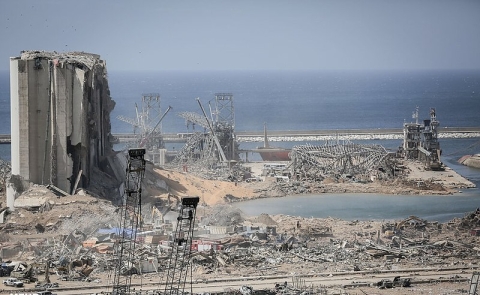
Have we forgotten the lessons of the past?
In the late afternoon of 4 August 2020, two terrible explosions devastated the port and the centre of Beirut.
Half of the city was affected, with dozens of victims (140 dead) and thousands injured. 300,000 people are homeless. The governor of the city already estimates the damage at more than 3 billion dollars. Extensive damage was reported in the vicinity of the explosion, which was felt over 40 kilometres away. The sound wave was reportedly heard in Cyprus, over 200 km away. The US earthquake monitoring agency has estimated that the Beirut explosion is equivalent to an earthquake measuring 3.3 on the Richter scale.
Of course, we will have to wait for expert analysis and reports, but the authorities favour the theory of an accidental explosion of 2,750 tonnes of ammonium nitrate which had been requisitioned six years ago from a ship and left in a warehouse.
Ammonium nitrate is a synthetic compound of ammonia and nitric acid. Under poor storage conditions, it can react to a contaminant, moisture or shock and decompose. Over time, the likelihood of such a reaction increases, the ammonium nitrate stockpile can rapidly degrade, generate its own heat and ultimately explode.
This is not the first time a depot has exploded:
In 1921, about 4,500 tonnes of ammonium nitrate caused a factory explosion in Oppau, Germany, killing more than 500 people.
In 1942, an explosion of 300 tonnes of ammonium nitrate occurred at the P.C.T. factory in Tessenderlo.
In 1947, in the port of Galveston Bay (Texas City), 581 people were killed when a ship loaded with more than 2,000 tonnes of the product exploded.
More recently,
In 2001, on 21 September, 300 tonnes of ammonium nitrate stored in an AZF hangar in Toulouse suddenly exploded, killing 31 people.
In 2013, on 17 April, the West fertiliser plant in Texas exploded, killing 15 people.
These disasters - and the many other examples, fortunately not all as deadly - have been analysed and duly documented. Since the 1940s, the dangers of ammonium nitrate and nitrogen fertilisers have become better known and strict safety regulations have been imposed on the manufacture and storage of these products. Thanks to these rules, the human impact of accidents was more limited.
Leaving such a stockpile uncontrolled and unprotected in a warehouse in a commercial port and near residential areas is like setting off a bomb in the heart of the city.
It is still too early to say what the initial phenomenon was that triggered the explosion. We will come back to this as soon as the first conclusions of the experts are known.
For the time being, let us conclude that our companies producing and storing ammonium nitrate are subject to the so-called Seveso regulations. These regulations impose very strict safety measures and are regularly monitored by our authorities.
We will come back to ammonium nitrate in a future article in Fire & Security Alert Magazine.






